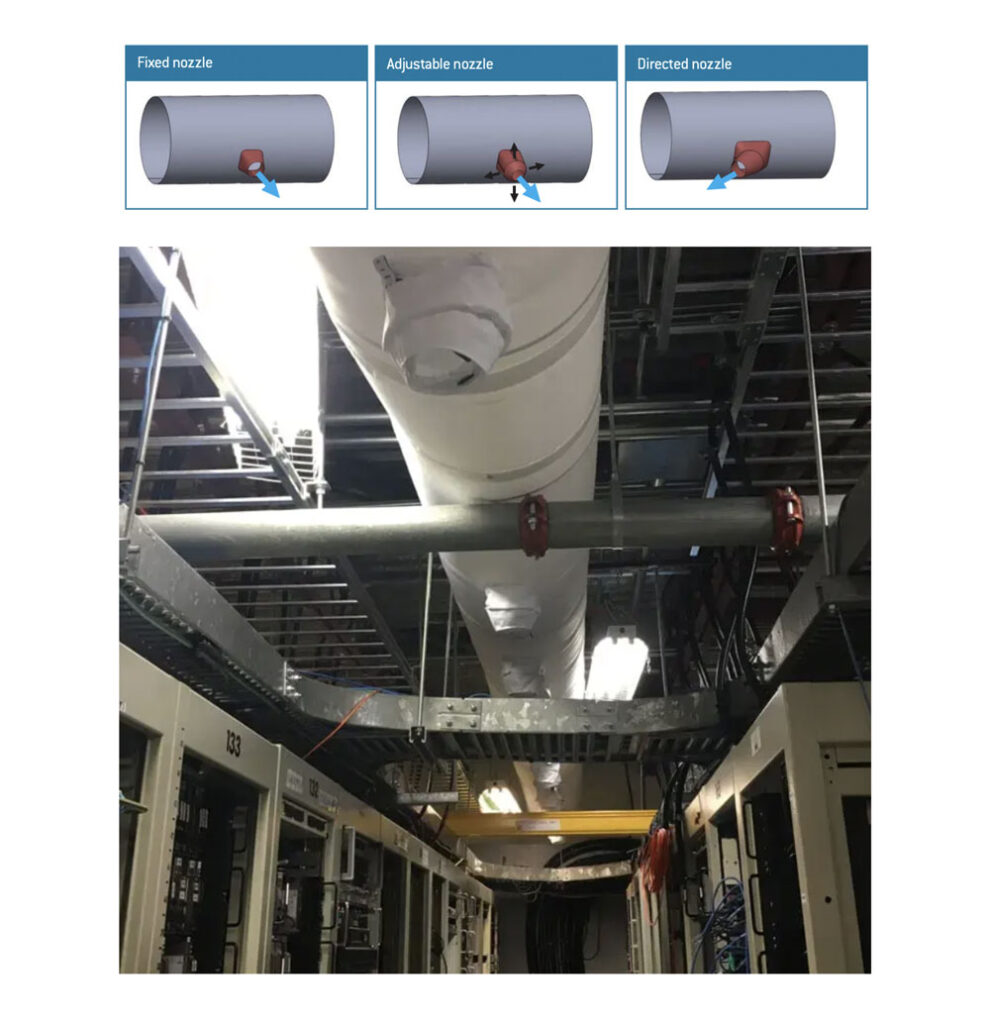
Sophisticated air control meets modular flexibility
At Prihoda, we’ve spent years developing solutions that solve real‑world air distribution problems across many industries. When it comes to data centers and server rooms, we’ve seen a clear shift.
Higher heatloads, tighter efficiency targets, and constantly evolving equipment have made one thing obvious:traditional metal ducting is no longer enough.
As part of Prihoda’s engineering team, we’ve worked on numerous cooling system designs forfacilities of every size. The challenges are consistent.
Operators are looking for systems that are fasterto install, easierto adapt, and capable of delivering uniform airflow across high‑density server
setups.
That’s exactly where our fabric ducting systems, especially with Helix tensioning, provide a clear advantage. They’re not just for hyperscale halls—server closets and modular edge deployments benefit just as much.
The Limits of Traditional Cooling Setups
Conventional CRAC/CRAH systems with metal ducts and raised floors served the industry well for decades.
But those systems were designed for a different era. Today’s data centers and server rooms are denser, hotter, and evolving faster. We’ve seen many facilities struggling with uneven cooling.
Hot spots near critical equipment, long downtime for duct reconfiguration, and inefficient energy usage are common.
Metal ducts are rigid and heavy; once installed, changing them is slow, expensive, and disruptive. That rigidity just doesn’t align with the pace or flexibility required in modern data environments.
What Fabric Ducting Offers That Metal Can’t
Our textile air dispersion systems are built to perform where metal struggles. They’re lightweight, simple to install, and fully customizable to your layout.
“Data centers built with modular fabric ducting are roughly 40–60 % less expensive than traditional metal air highways, and the modular design allows for easy reconfiguration if space needs change.“
In server rooms where space is tight and change happens often, that flexibility is invaluable. Fast and simple installation, with easy reconfiguration, at a fraction of the cost—that’s the Prihoda advantage.
From an engineering perspective, the adaptability is what makes fabric systems ideal for modular and edge facilities.
Adjustable nozzles and our patented internal dampers give users precise control over how air moves and where it goes.

This variable air distribution is perfect for hot‑aisle/cold‑aisle containment; you can modulate airflow based on server demand and heat load without ripping out ducts.
Using a rectangular duct in a negative pressure application allows full linear extraction of hot air from the entire aisle, improving heat removal
efficiency and reducing both the amount and the temperature of supply air required. Less wasted energy, more efficient cooling.
Designed for Underfloor, Overhead and Contained Systems
One of the strengths of fabric ducting is its flexibility in application. We’ve designed systems that work seamlessly in raised floor environments, delivering air through perforated tiles with remarkable precision.
In overhead installations, the ducts can follow complex paths and adjust easily to obstructions or support structures. They’re also perfect for cold aisle and hot aisle containment systems, where airflow needs to be targeted and clean separation is essential.
Because our ducts are custom-built to specification, every inch of airflow is accounted for in the design. There’s no guesswork. What’s modeled is exactly what gets built.
A Sustainable Approach Without Compromising Performance
Sustainability is no longer a bonus in data center design—it’s a requirement.
Many of our fabric ducts are made from recycled materials, and custom‑engineered air distribution not only improves airflow but helps save energy. Because the ducts are lightweight and compact, transportation emissions are lower.
Reduced material waste, minimal maintenance, and long operational life all contribute to a lower total cost of ownership. On top of that, our
materials are antistatic and fire‑retardant, which is critical in protecting sensitive electronics and meeting safety regulations.
Real‑World Value in Every Application
We’ve supplied fabric ducting systems for data centers of all sizes, from hyperscale operations to small server rooms tucked into office closets.
The flexibility in design allows us to complement advanced cooling technologies like immersion and direct‑to‑chip systems by handling residual heat and humidity
Thanks to modular sections, our ducts can be customized and easily retrofitted to replace metal ducts in existing cooling systems. Fabric ducts
are cheaper than metal ones and easier to install; permeable fabric doesn’t sweat when cooling below the dew point and can replace insulated or double‑wall metal ducts.
They can also be moved or changed around as your facility grows or changes. Maintenance is simple—easy‑on, easy‑off diffusers can be
cold‑laundered, and if any section gets damaged, you can replace just that part.
A Smarter Cooling Strategy Starts with Better Airflow Design
Data centers and server rooms are no longer one‑size‑fits‑all. Infrastructure is evolving rapidly, and so are the expectations for cooling performance.
Prihoda fabric ducting gives operators a way to respond to these changes with a system that is lightweight, efficient, and precise. From faster
deployment timelines to long‑term energy and maintenance savings, the benefits of fabric ducting extend well beyond the initial installation. It’s a solution engineered not just for where facilities are today but where they’re headed next.
If you’re evaluating options for airflow distribution in your next project—or rethinking how your existing facility handles heat and pressure—our team is ready to help design a system that works from day one and grows with your infrastructure.
Data Center and Server Room Cooling FAQs
Is fabric ducting durable enough for critical environments like data centers and server rooms?
Yes. Our fabric ducts are engineered for continuous use in high‑demand environments. The materials are fire‑retardant, antistatic, and resistant to microbial growth. With proper maintenance, they can last as long as or longer than traditional metal ductwork.
Can Prihoda ducts handle both supply and return air applications?
Absolutely. Using our Helix full‑tensioning system, we can design ducts for both positive pressure (supply) and negative pressure (return) systems. This dual capability makes it easierto manage airflow balance throughout the facility.
How does airflow distribution compare with metal ducts?
Fabric ducts offer more uniform air distribution due to directional perforations and even pressure retention across the duct. Adjustable
nozzles and internal dampers allow you to focus airflow where it’s needed, which helps eliminate hot spots and reduces the risk of over‑ or under‑cooling specific zones.
Are these systems compatible with raised floor designs and server rooms without raised floors?
Yes. We regularly design ducts for underfloor systems, including those that deliver conditioned air through perforated tiles. In smaller server rooms with limited vertical space, overhead or wall‑mounted fabric ducts provide even air dispersion without the bulk of metal.
Can fabric ducts be adapted to both large data halls and small server rooms?
Yes. Our modular design scales from hyperscale data halls to single‑rack server closets. Fabric ducts can be customized and easily retrofitted to
replace metal ducts, and they can be moved or changed around as your facility evolves.
How long does installation typically take compared to metal ducting?
Installation time is significantly reduced. Fabric ducts are lightweight, shipped compactly, and require no welding or heavy equipment. In most projects, install times are cut by 40 to 60 percent compared to metal, and the modular nature makes future changes painless.
Is fabric ducting more expensive than traditional ductwork?
While the per‑foot cost of metal may sometimes appear lower, the total installed cost of fabric ducting—including faster install time, lower transport costs, reusable sections, and reduced maintenance—is often lower over the system’s life cycle. When you factor in energy savings from improved airflow, fabric ducting delivers value that metal simply can’t match.
 English
English Français
Français
